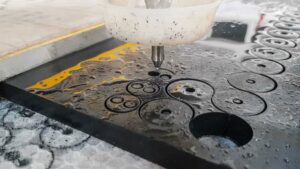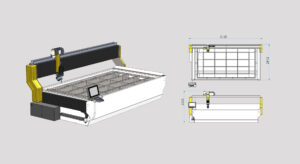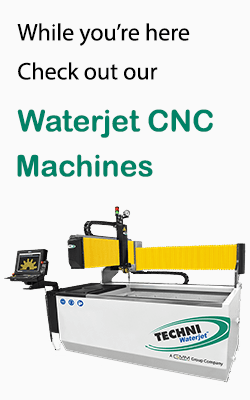Waterjet cutting technology is the dominant cutting process in the market nowadays. More and more manufacturers are switching over to water jet cutters as the advantages provided by these machines are countless.
Waterjet cutters can cut precise parts for any industry that requires them as these cutters can work on virtually any material. However, cutting with these cutters isn’t as simple as using a saw blade
When using waterjet cutters, there are certain terminologies you need to be aware of. One of them is the water jet cutting tolerance.
This article will tell you all you need to know about water jet cutting tolerance, why it is important, and how to calculate it for your machine. Keep reading to find out more.
How accurate is the waterjet cutting technology?
One of the best things about waterjet cutters is that these machines are very accurate.
Why are we discussing accuracy? It is because that is what cutting tolerance is all about.
Cutting tolerance refers to the slight shift in the position of the actual cut from the intended cut.
This shift takes place in all cutting methods. However, for technologies such as waterjet technology, this shift is close to negligible.
What is the average cutting tolerance of a waterjet machine?
Typically, waterjet machines offer a cutting tolerance of ± 0.002” (0.05 mm). Some waterjet cutters even trim this down to ± 0.001” (0.025 mm).
This shift is so little that you can’t see it with a naked eye. In fact, this scale is so small that you won’t even be able to measure it with a regular ruler.
What factors can affect the cutting tolerance and accuracy of waterjet cutting?
Many factors influence the cutting tolerance in a waterjet machine. These factors include:
- Speed of Cutting – As is quite obvious, the faster you operate the machine, the less accurate it will be, leading to a higher tolerance.
- Abrasive Quality – Lower quality abrasives are inconsistent in size, leading to improper cuts and a higher cutting tolerance. A higher-quality abrasive has consistent grains, so it can provide a lower cutting tolerance and more precise cuts.
- Material Thickness – A material of higher thickness will have a higher tolerance than thinner materials. This is because for very thick material, there is less control on the behavior of the waterjet stream as it exits the material, leading to lesser accuracy.
- Material Hardness – Harder materials usually have less taper (the distance in kerf in the entry and exit point of water stream in the workpiece). Less taper means higher accuracy, so harder materials can provide lower tolerance.
- Positioning of the Machine – Sometimes, a higher tolerance is the result of improper positioning of the waterjet cutting machine. For accurate cuts and lower tolerance, you need to position the machine accurately, taking into account factors such as the waterjet kerf and offset.
- Condition of cutter – A well-maintained waterjet cutter will have better accuracy than a water jet cutter where the nozzles are worn out or spare parts require replacement. For best accuracy, it is important to use the spare parts as prescribed by the manufacturer.
- Stability of the Table – If there are any vibrations in the workpiece due to external instability, there can be blemishes and marks in the part being cut. These marks are called witness marks and they can cause a higher tolerance than required.
- Machine Operator Skills – Even though a waterjet cutter can work automatically connected to the controller, the operator needs to be skilled as well. A skilled operator will be aware of all the factors that affect tolerance and will set up the waterjet cutter accordingly.
- Software – The software that runs the controller determines the positioning accuracy of the waterjet cutter. The positioning accuracy will play a big role in the resultant tolerance. Therefore, better software can provide a lower tolerance.
- Controller Type – There are a lot of different controllers available in the market for waterjet cutting machines. A high-end controller can provide a lower tolerance for the cuts.
3. What is the optimal cutting tolerance that can be achieved with a waterjet?
The optimal cutting tolerance, i.eThe minimum cutting tolerance that is obtainable with a waterjet cutter mainly depends on the machine you are using. This obtainable tolerance can vary from manufacturer to manufacturer.
Nowadays, due to improved engineering, many machines are able to provide a tolerance as low as ± 0.001″ (0.025 mm).
4. How does waterjet accuracy compare to other cutting methods?
An interesting thing to note is that waterjet cutting provides one of the lowest cutting tolerance of any process you consider. This is why it is the method of choice for most industrial requirements nowadays.
One of the main reasons for the very tight tolerances is that waterjet cutting does not involve any contact of the machine head with the workpiece. There is no raise in temperature of the workpiece, so its structural integrity is preserved.
However, most other cutting processes involve a thermal rise near the point of impact, creating a heat-affected zone. This increases the tolerance of the process significantly.
Here is a table of comparison of cutting tolerance of various processes that are common nowadays:
Tolerance (inches):
- Waterjet Cutting: ±0.001”
- Laser Cutting: ±0.005”
- Oxy-fuel Cutting: ±0.06”
- EDM Cutting: ±0.0001”
- Plasma Cutting: ±0.02”
Endnotes
If you are using a waterjet cutter for parts where even a fraction of a millimeter can make a big difference, the water jet cutting tolerance is something you should account for.
However, if you look at the big picture and compare a waterjet cutter to other alternatives, you will find that this method provides the highest accuracy you can achieve out there.
As mentioned in the article, a good quality machine can provide the lowest tolerances out there. If you are aiming for the lowest tolerance, you should check out the waterjet cutters provided by TechniWaterjet
TechniWaterjet has waterjet cutting machines with the highest standards of reliability, offering you the complete package. The water jet cutters are coupled with software that fulfills all criteria and comes with preloaded designs for common cuts, and the ability to create any customized designs you require.
Frequently Asked Questions (FAQs)
Here are the answers to some common doubts that people come across when discussing water jet cutting tolerance:
What is the difference in accuracy between pure and abrasive waterjet?
For cutting of very soft or delicate materials like rubber, foam, and paper, pure waterjet is the more accurate choice. For cutting harder materials, an abrasive waterjet turns out to be more accurate.
Is there any cutting process with zero cutting tolerance?
Every cutting process will have some amount of tolerance, however less. Among the various processes, waterjet cutting provides one of the lowest tolerances that is almost negligible.
What is the difference between kerf and cutting tolerance?
Kerf is the amount of material removed from the workpiece during the cutting process. Cutting tolerance is the shift in the position of the actual cut as compared to the intended cut. Kerf is always positive, while the cutting tolerance can be positive and negative.
Is cutting tolerance important to take into account?
The importance of cutting tolerance depends on the job you need to undertake. For waterjet cutters, the cutting tolerance is important only when your job requires the precision of a fraction of a millimeter.





